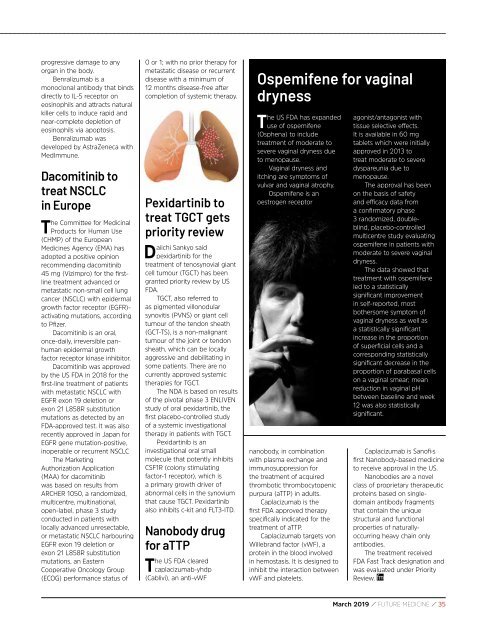March 2019 digital v1
Create successful ePaper yourself
Turn your PDF publications into a flip-book with our unique Google optimized e-Paper software.
progressive damage to any<br />
organ in the body.<br />
Benralizumab is a<br />
monoclonal antibody that binds<br />
directly to IL-5 receptor on<br />
eosinophils and attracts natural<br />
killer cells to induce rapid and<br />
near-complete depletion of<br />
eosinophils via apoptosis.<br />
Benralizumab was<br />
developed by AstraZeneca with<br />
MedImmune.<br />
Dacomitinib to<br />
treat NSCLC<br />
in Europe<br />
The Committee for Medicinal<br />
Products for Human Use<br />
(CHMP) of the European<br />
Medicines Agency (EMA) has<br />
adopted a positive opinion<br />
recommending dacomitinib<br />
45 mg (Vizimpro) for the firstline<br />
treatment advanced or<br />
metastatic non-small cell lung<br />
cancer (NSCLC) with epidermal<br />
growth factor receptor (EGFR)-<br />
activating mutations, according<br />
to Pfizer.<br />
Dacomitinib is an oral,<br />
once-daily, irreversible panhuman<br />
epidermal growth<br />
factor receptor kinase inhibitor.<br />
Dacomitinib was approved<br />
by the US FDA in 2018 for the<br />
first-line treatment of patients<br />
with metastatic NSCLC with<br />
EGFR exon 19 deletion or<br />
exon 21 L858R substitution<br />
mutations as detected by an<br />
FDA-approved test. It was also<br />
recently approved in Japan for<br />
EGFR gene mutation-positive,<br />
inoperable or recurrent NSCLC<br />
The Marketing<br />
Authorization Application<br />
(MAA) for dacomitinib<br />
was based on results from<br />
ARCHER 1050, a randomized,<br />
multicentre, multinational,<br />
open-label, phase 3 study<br />
conducted in patients with<br />
locally advanced unresectable,<br />
or metastatic NSCLC harbouring<br />
EGFR exon 19 deletion or<br />
exon 21 L858R substitution<br />
mutations, an Eastern<br />
Cooperative Oncology Group<br />
(ECOG) performance status of<br />
0 or 1; with no prior therapy for<br />
metastatic disease or recurrent<br />
disease with a minimum of<br />
12 months disease-free after<br />
completion of systemic therapy.<br />
Pexidartinib to<br />
treat TGCT gets<br />
priority review<br />
Daiichi Sankyo said<br />
pexidartinib for the<br />
treatment of tenosynovial giant<br />
cell tumour (TGCT) has been<br />
granted priority review by US<br />
FDA.<br />
TGCT, also referred to<br />
as pigmented villonodular<br />
synovitis (PVNS) or giant cell<br />
tumour of the tendon sheath<br />
(GCT-TS), is a non-malignant<br />
tumour of the joint or tendon<br />
sheath, which can be locally<br />
aggressive and debilitating in<br />
some patients. There are no<br />
currently approved systemic<br />
therapies for TGCT.<br />
The NDA is based on results<br />
of the pivotal phase 3 ENLIVEN<br />
study of oral pexidartinib, the<br />
first placebo-controlled study<br />
of a systemic investigational<br />
therapy in patients with TGCT.<br />
Pexidartinib is an<br />
investigational oral small<br />
molecule that potently inhibits<br />
CSF1R (colony stimulating<br />
factor-1 receptor), which is<br />
a primary growth driver of<br />
abnormal cells in the synovium<br />
that cause TGCT. Pexidartinib<br />
also inhibits c-kit and FLT3-ITD.<br />
Nanobody drug<br />
for aTTP<br />
The US FDA cleared<br />
caplacizumab-yhdp<br />
(Cablivi), an anti-vWF<br />
Ospemifene for vaginal<br />
dryness<br />
The US FDA has expanded<br />
use of ospemifene<br />
(Osphena) to include<br />
treatment of moderate to<br />
severe vaginal dryness due<br />
to menopause.<br />
Vaginal dryness and<br />
itching are symptoms of<br />
vulvar and vaginal atrophy.<br />
Ospemifene is an<br />
oestrogen receptor<br />
nanobody, in combination<br />
with plasma exchange and<br />
immunosuppression for<br />
the treatment of acquired<br />
thrombotic thrombocytopenic<br />
purpura (aTTP) in adults.<br />
Caplacizumab is the<br />
first FDA approved therapy<br />
specifically indicated for the<br />
treatment of aTTP.<br />
Caplacizumab targets von<br />
Willebrand factor (vWF), a<br />
protein in the blood involved<br />
in hemostasis. It is designed to<br />
inhibit the interaction between<br />
vWF and platelets.<br />
agonist/antagonist with<br />
tissue selective effects.<br />
It is available in 60 mg<br />
tablets which were initially<br />
approved in 2013 to<br />
treat moderate to severe<br />
dyspareunia due to<br />
menopause.<br />
The approval has been<br />
on the basis of safety<br />
and efficacy data from<br />
a confirmatory phase<br />
3 randomized, doubleblind,<br />
placebo-controlled<br />
multicentre study evaluating<br />
ospemifene in patients with<br />
moderate to severe vaginal<br />
dryness.<br />
The data showed that<br />
treatment with ospemifene<br />
led to a statistically<br />
significant improvement<br />
in self-reported, most<br />
bothersome symptom of<br />
vaginal dryness as well as<br />
a statistically significant<br />
increase in the proportion<br />
of superficial cells and a<br />
corresponding statistically<br />
significant decrease in the<br />
proportion of parabasal cells<br />
on a vaginal smear; mean<br />
reduction in vaginal pH<br />
between baseline and week<br />
12 was also statistically<br />
significant.<br />
Caplacizumab is Sanofi›s<br />
first Nanobody-based medicine<br />
to receive approval in the US.<br />
Nanobodies are a novel<br />
class of proprietary therapeutic<br />
proteins based on singledomain<br />
antibody fragments<br />
that contain the unique<br />
structural and functional<br />
properties of naturallyoccurring<br />
heavy chain only<br />
antibodies.<br />
The treatment received<br />
FDA Fast Track designation and<br />
was evaluated under Priority<br />
Review.<br />
<strong>March</strong> <strong>2019</strong> / FUTURE MEDICINE / 35


















